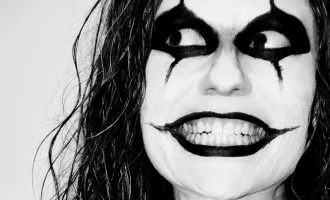
Graphic art created by Michelle Bui.
The (Graphic) Art of Medicine
Medicine may seem an unlikely subject for comic books but think again. The UCSF Library recently kickstarted its inaugural Graphic Medicine Collection with fifty-one comics and graphic novels that engage health or medical themes.
In celebration of the opening, the Library hosted a virtual comic-creating workshop on Oct. 13 for a guided opportunity to try drawing our own medical comics while answering the question some of us might have been wondering: What do comics have to do with medicine?
The workshop was led by Brian Fies, an award-winning cartoonist whose work, Mom’s Cancer, is featured in the UCSF Library’s recently acquired collection.
Fies had worked as a freelance journalist and artist until his early 40s, when his mother was diagnosed with metastatic lung cancer.
One day, he accompanied his mom to her chemotherapy session and decided to record what he saw. First, he drew his mom sitting in her chair, with the IV bag hanging next to her, and he documented the medicines and their rates of flow. But he also included the strawberry milkshake they had purchased earlier that day from Jack in the Box and the walking stick she had whittled herself on several hiking trips.
Comics, Fies emphasized, are words and images that transcend the sum of their parts. They allow us to show and tell our stories. Fies felt he had captured that day’s experience of his mom’s chemo from his own simple, quickly-drawn sketch. He found solace in processing the emotional and practical effects of his mom’s illness on her and her loved ones through his webcomic and has since become active in the field of graphic medicine.
Graphic medicine, a term coined in 2007 to define the ”intersection between the medium of comics and the discourse of healthcare," brings together text and imagery into an accessible format. Graphic medicine aims to instill a sense of universality and empathy in the diverse experiences of patients, healthcare providers, and community members.
Particularly during the COVID-19 pandemic, graphic medicine has stood out as a powerful and effective platform for health information and personal stories.
In addition to the public health focus of many graphic medicine works such as No Ordinary Flu, about the 1918 flu, many others are simply personal stories meant to be shared with others. Healthcare providers write about being healthcare providers, like in Medical Student: A Tragic Comedy. Others, such asTaking Turns: stories from HIV/AIDS Care Unit 371 are bona fide works of medical journalism. The vast majority of graphic medicine, though, is written by patients and caregivers like Fies about their deeply personal experiences with health and healthcare.
As the workshop audience worked to draw medical experiences from their own lives, Fies answered another important question: do you need to be artistically talented to make comics?
“You don’t have to be a good artist to be a good cartoonist,” he said. “Cartooning is storytelling. Telling a story clearly, honestly, and authentically is more important than craft.”
Fies’ Mom’s Cancer is now available to borrow as an e-book from the UCSF Library, along with other well-known works such as Menopause: A Comic Treatment, El Deafo, My Degeneration: A Journey Through Parkinson’s, and more.



